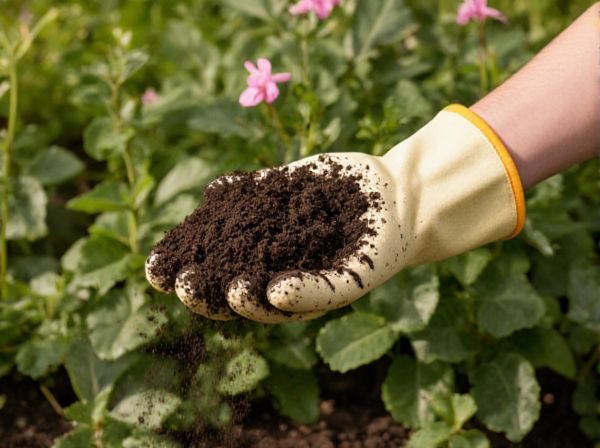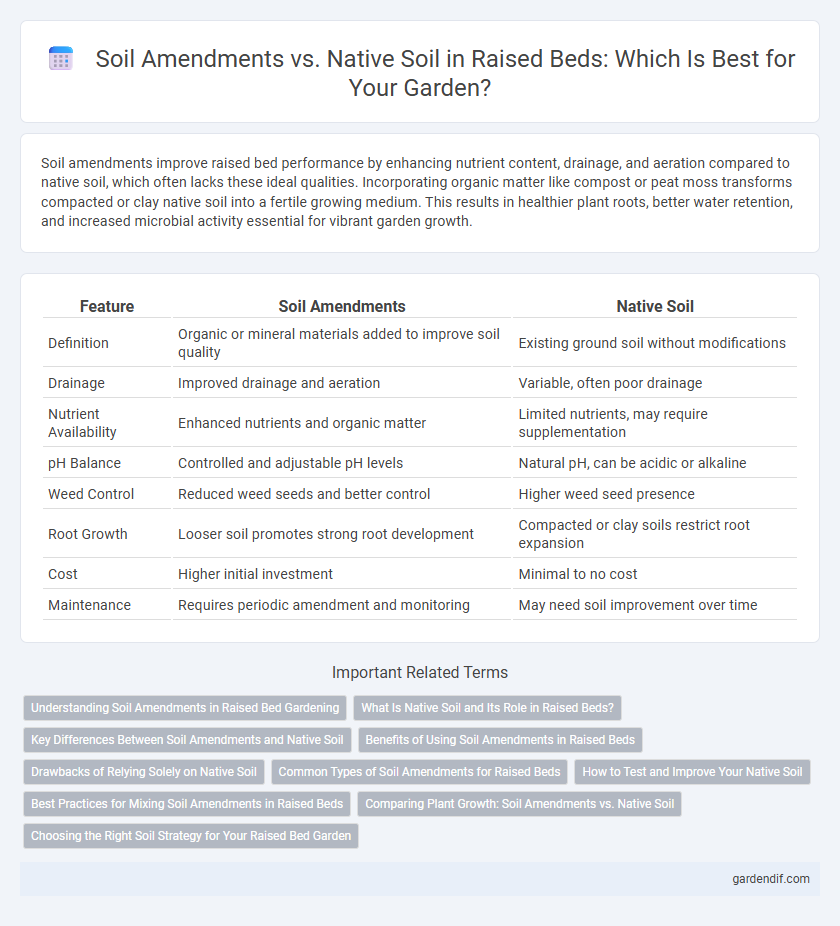
Soil amendments vs Native soil Illustration
Soil amendments improve raised bed performance by enhancing nutrient content, drainage, and aeration compared to native soil, which often lacks these ideal qualities. Incorporating organic matter like compost or peat moss transforms compacted or clay native soil into a fertile growing medium. This results in healthier plant roots, better water retention, and increased microbial activity essential for vibrant garden growth.
Table of Comparison
| Feature | Soil Amendments | Native Soil |
|---|---|---|
| Definition | Organic or mineral materials added to improve soil quality | Existing ground soil without modifications |
| Drainage | Improved drainage and aeration | Variable, often poor drainage |
| Nutrient Availability | Enhanced nutrients and organic matter | Limited nutrients, may require supplementation |
| pH Balance | Controlled and adjustable pH levels | Natural pH, can be acidic or alkaline |
| Weed Control | Reduced weed seeds and better control | Higher weed seed presence |
| Root Growth | Looser soil promotes strong root development | Compacted or clay soils restrict root expansion |
| Cost | Higher initial investment | Minimal to no cost |
| Maintenance | Requires periodic amendment and monitoring | May need soil improvement over time |
Understanding Soil Amendments in Raised Bed Gardening
Soil amendments in raised bed gardening improve soil structure, enhance nutrient availability, and increase moisture retention compared to native soil, which often lacks essential organic matter. Common amendments include compost, peat moss, and vermiculite, each contributing to better aeration and root development. Properly amending soil ensures optimal growing conditions, leading to healthier plants and higher yields in raised beds.
What Is Native Soil and Its Role in Raised Beds?
Native soil refers to the original soil present at a garden site before any modifications, containing its natural composition of minerals, organic matter, and microorganisms. In raised beds, native soil plays a crucial role by providing a stable foundation, influencing drainage, and interacting with added soil amendments to support plant health. Understanding the characteristics of native soil helps gardeners decide the types and quantities of soil amendments needed to optimize nutrient availability and soil structure for raised bed cultivation.
Key Differences Between Soil Amendments and Native Soil
Soil amendments improve native soil by enhancing texture, nutrient content, and water retention, leading to healthier plant growth. Native soil varies by location and often lacks optimal fertility and structure, requiring amendments to balance pH and enrich organic matter. Understanding the differences ensures raised beds maintain proper aeration, drainage, and nutrient availability essential for crop productivity.
Benefits of Using Soil Amendments in Raised Beds
In raised beds, soil amendments enhance nutrient availability and improve soil structure, leading to better root development and increased plant growth. Incorporating organic matter such as compost or peat moss boosts moisture retention and aeration compared to native soil. These benefits result in higher crop yields and healthier plants, making soil amendments essential for optimal raised bed gardening.
Drawbacks of Relying Solely on Native Soil
Relying solely on native soil for raised beds often results in poor drainage, low nutrient availability, and inconsistent soil structure, which can hinder plant growth and yield. Native soil may contain high levels of clay or sand, leading to compaction or rapid water loss, limiting root development and aeration. Without proper soil amendments such as compost, peat moss, or vermiculite, the raised bed's productivity and overall soil health can deteriorate over time.
Common Types of Soil Amendments for Raised Beds
Common types of soil amendments for raised beds include organic matter such as compost, aged manure, and peat moss, which improve soil structure, water retention, and nutrient content compared to native soil. Mineral amendments like perlite, vermiculite, and sand enhance aeration and drainage, crucial for healthy root development in raised bed environments. Adding these amendments balances pH levels and replenishes essential nutrients often deficient in native soil, promoting optimal plant growth.
How to Test and Improve Your Native Soil
Testing native soil begins with collecting samples from multiple locations in the raised bed area to assess pH, nutrient levels, and soil texture through a soil test kit or local extension service. Improving native soil involves incorporating organic matter such as compost, aged manure, or peat moss to enhance fertility, structure, and moisture retention. Adjust pH by adding lime to raise alkalinity or sulfur to increase acidity based on soil test results for optimal plant growth in raised beds.
Best Practices for Mixing Soil Amendments in Raised Beds
Mixing soil amendments with native soil in raised beds enhances nutrient availability, improves soil structure, and boosts water retention, essential for optimal plant growth. Best practices include thoroughly blending 2 to 4 inches of compost or organic matter into the top 6 to 12 inches of native soil, ensuring even distribution to avoid layering that can hinder root development. Incorporating amendments based on soil test results tailors nutrient levels, promoting a balanced environment for healthy root systems and increased crop yields.
Comparing Plant Growth: Soil Amendments vs. Native Soil
Soil amendments enhance nutrient content, improve aeration, and increase water retention compared to native soil, leading to more vigorous plant growth. Studies show plants in amended soil often exhibit greater biomass, deeper root systems, and higher yields than those grown in unaltered native soil. Modifying native soil with organic matter or compost creates a more optimal growing environment, promoting healthier and more productive plants.
Choosing the Right Soil Strategy for Your Raised Bed Garden
Soil amendments enhance nutrient content, improve drainage, and boost soil structure in raised bed gardens, creating an ideal growth environment compared to native soil, which may lack essential nutrients or have poor texture. Incorporating organic matter like compost or peat moss balances pH levels and increases microbial activity, promoting healthier plant roots and higher yields. Selecting the right soil strategy involves assessing native soil quality and supplementing it with targeted amendments to optimize fertility and water retention for vibrant raised bed garden results.
Soil amendments vs Native soil Infographic

 gardendif.com
gardendif.com